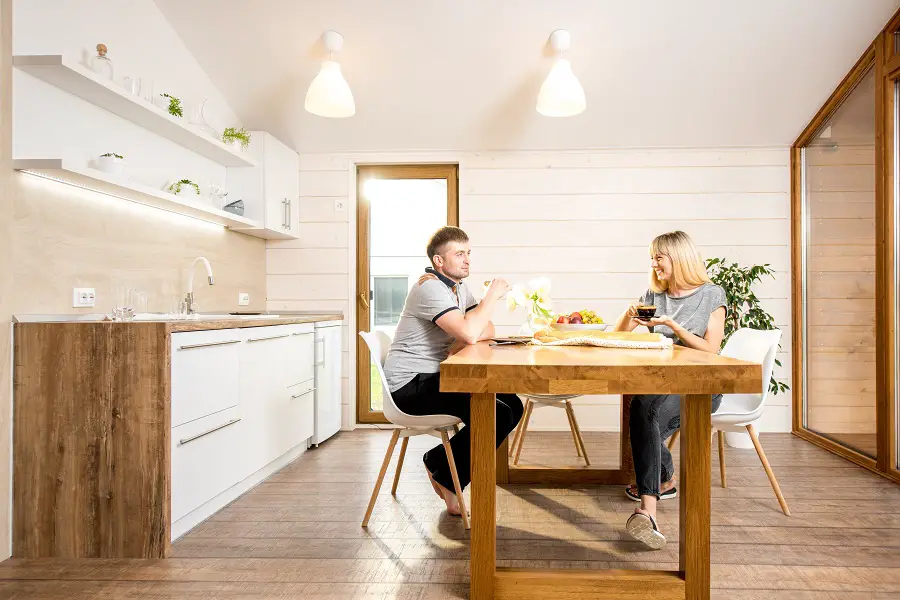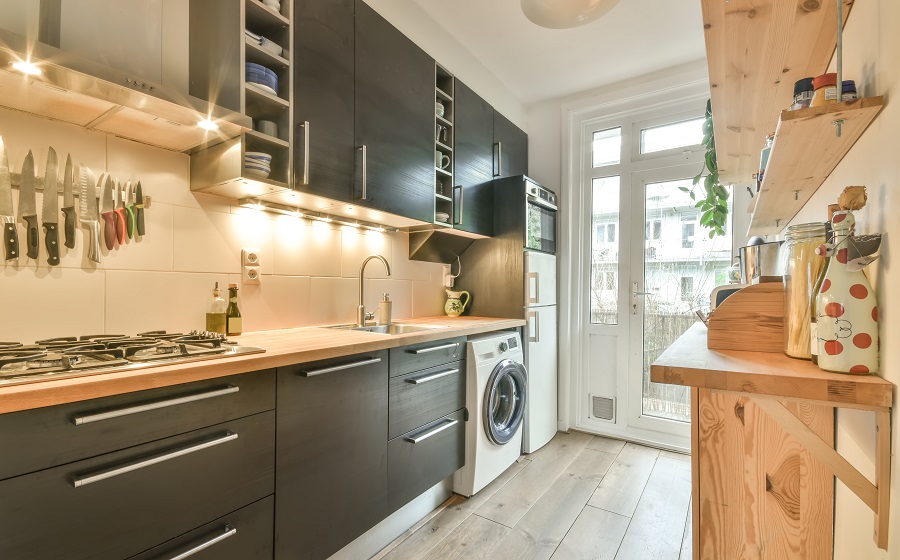Cis the best method for protecting a solid wood kitchen countertop? The answer is special oil for table tops (hard top oil), tung oil or hardening varnishes (polyurethane, acrylic). But this is a question that needs to be answered in more detail. Because kitchen tables and worktops have to withstand different conditions from the rest of the furniture in the house. Their finish has to be resistant to scratching, knocks, high humidity and temperature, staining with cold or hot liquids, alcohol, wine or coffee. The conditions in the kitchen require conditions not only for the finish but also for the wood and the glue used for gluing.

Tough kitchen conditions call for tougher finishing products
Not all finishing products have the same surface properties. Some bleach in prolonged contact with water or steam and will flake or wash off quickly if in permanent contact with a water source. Others scratch very easily, sometimes even larger grains of dust can cause problems. Finishing products are generally thermoplastic, but some soften very quickly in contact with hot sources. Their resistance to solvents also varies. Some have no problem if wiped with alcohol, while others soften as soon as they come into contact with alcohol. And the examples could go on.
Kitchen conditions are the most difficult in the house because all of the above challenges and more are possible. In a functional kitchen there are sources of steam, countertops can come into contact with hot sources which can be dry or wet, there is the possibility of water, cold or hot, standing for a long time on the finished surface. Surfaces may be subject to scratching or rubbing, they may come into contact with alcohol or substances that can stain them - fruit or vegetable juice, coffee, wine. That's why you can't treat the finishing of kitchen worktops like that of any piece of furniture.
The properties of wood are as important as those of the finish
As a solid wood kitchen worktop, the species is also important. The wood chosen should be one of the hard woods with good scratch resistance (oak, pine, ash, beech). The finish, however good and resistant it may be, is still a fine chip. If the top is subjected to a mechanical shock - knocking, scratching, indentation - the finish cannot withstand it on its own if the wood cracks.
Moisture resistance is also important. No matter how well finished, there will always be places where steam or moisture can penetrate the wood. Poor moisture resistance of wood can lead to fungal infestation which means compromising him. Mould stains appear, the wood becomes brittle in some areas and gradually we find that it should be replaced.

The most suitable materials for protecting wooden kitchen worktops
Let's take them one by one. Ceara is not recommended. The film formed is not resistant to scratching and abrasion, it softens easily if it comes into contact with a hot source, it is not resistant to solvents, it stains easily. It also does not protect well against soiling, as the difficult conditions in the kitchen cause it to become soggy.
Oils. Linseed oil is not recommended. It is easily washed off and the finish needs to be redone quite often, even every 6 months.
Tung oil is a good choice. It resists moisture very well and forms a film resistant to mechanical action. It still needs to be applied patiently, in successive coats, for the film to be of good quality.
Danish oil is also a good choice. The condition is that it is of good quality. Danish oil is a mixture of linseed oil and tung oil. It is better the higher the percentage of tung oil. The combination is winning because the linseed oil goes deep into the wood and the shearing oil creates surface protection. As with tung oil, several coats are applied, and after complete drying the protection will be very good.
Synthetic oils. The appropriate ones are called hard top oil, i.e. hard surface oil. They are specially formulated for such uses and have very good mechanical resistance.
In general, oils form thin films and make the wood stand out. They are recommended for rustic finishes or natural. Their resistance over time may be less than other materials, but the finish can be refreshed without removing old layers.
Lacquers and paints. Nitrocellulose products - some of the most commonly used wood finishing materials - not recommended for kitchen countertops. The film does not have good scratch and abrasion resistance, softens in contact with hot sources or alcohol, whitens in prolonged contact with water, and will flake if the contact is permanent. Can stain with coffee and wine. It resists staining much better than wax, but cleaning must be done carefully without abrasives.
Hardening varnishes/paints are recommended because they have much better mechanical, physical and chemical resistance. Very good strengths have polyurethane varnishes. It resists scratching and high temperatures very well. In general, nothing happens to them even if the cigarette is extinguished on the countertop surface.
The higher the degree of reticulation, the more resistant the lake. In general, the degree of cross-linking is related to the amount of catalyst (hardener) added. A 100% hardener is harder than a 50% hardener. The amount of catalyst added is set by the manufacturer, it is not a parameter we can decide.
Polyester or acrylic varnishes with solvent or water-based curing also have good resistance.
Poutdoor rodwheels are not recommended for kitchen countertops. They are formulated to be more elastic, which makes them less hard. Moisture resistance refers to precipitation, not steam or hot water.
No matter how good a finishing product is, it must be applied correctly
Finishing materials may be very good, but they can't work wonders. It's what I used to say when I was selling varnishes and paints, it's what I say now. No matter how good a finishing product is, it can only reach its full capacity if it is applied correctly. For example, no matter how resistant a varnish is to scratching or knocks, there can be problems if sanding wood or between layers is not correctly done. In the event of a knock, the layers can come off because there is no adhesion. A very visible white streak appears at the site of the dent or scratch. This is not the fault of the varnish but of the sanding.
Another example. For the wood to be protected, it must be very well covered with film. If the wood has large pores, several coats, with drying and sanding, are needed to cover them. If only a few coats are applied and the technology is not followed, after a while the lacquer will fall in the pores and will not protect as well. The countertop will stain and get dirty more easily. It's not the varnish's fault but the technology's.
I hope you find the above information useful. As usual, additions are welcome. And if you have any questions or queries, please leave them in the space below. I'm sure I'll reply.






























Add comment